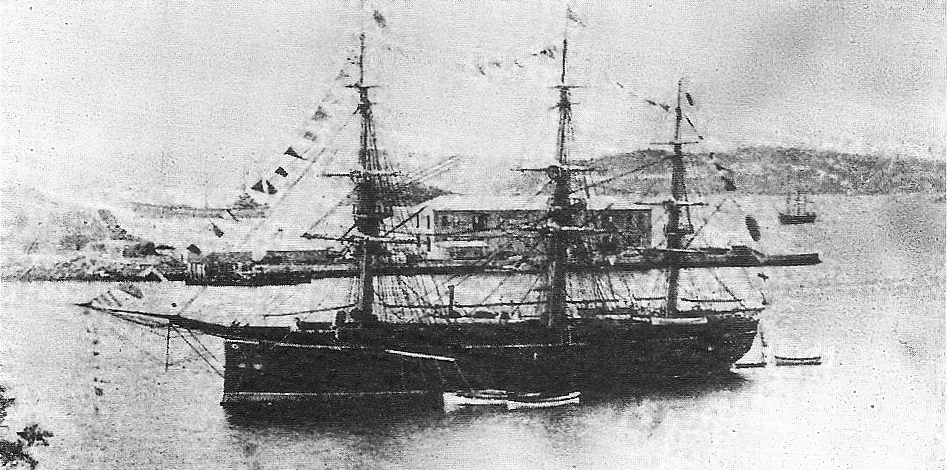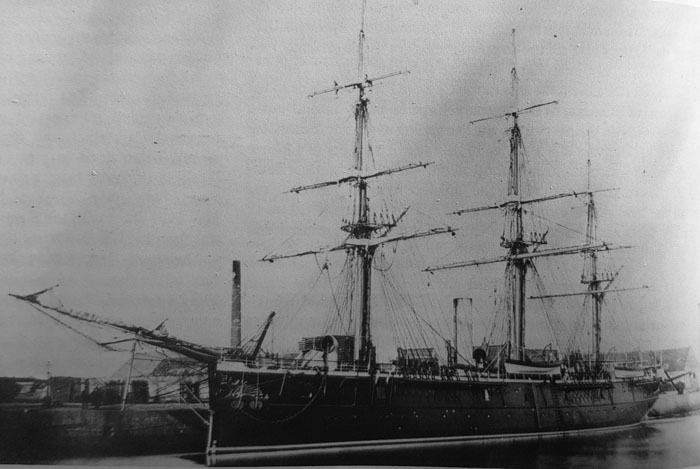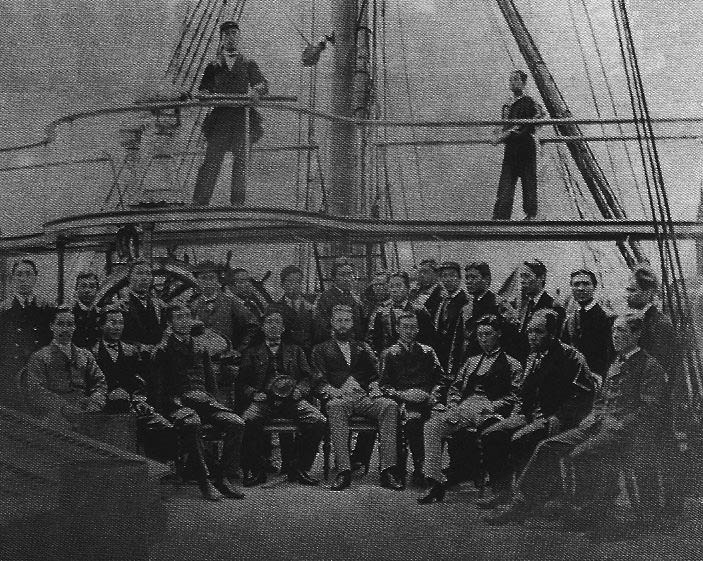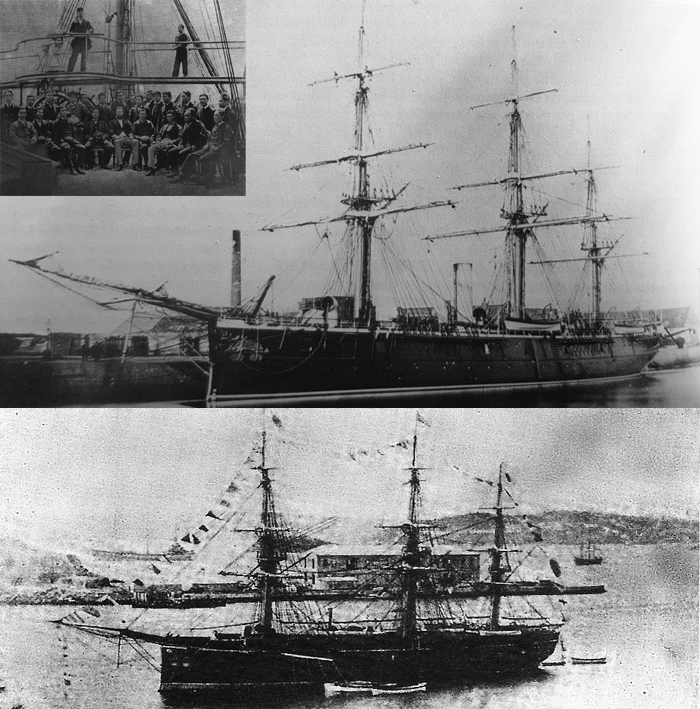
The first large sea-going Japanese Ironclad
A controversial origin
Ryūjō (龍驤, Prancing Dragon), was a British-built ironclad corvette purchased on behalf of a Japanese daimyo (clan lord) in 1870, who donated her to the fledgling IJN shortly after receiving her. She became thus the largest ship of the Imperial Japanese Navy, shortly after its creation following the Boshin war (1869). Initially she had been purchased by the daimyo of the Kumamoto clan in order to support the Shogunate cause, not joining the opposite faction. But she had been ordered not as a corvette, but as a wooden-hulled British merchant, noot even planned for the private navy of the fief of Kumamoto.

Jhosho Maru as completed in Aberdeen (CPL, Conways)
Instead, she was ordered by Thomas Blake Glover, a British merchant with extensive commercial interests in Japan, and secret clauses had her ordered unofficially as an armoured corvette from Aberdeen Yard in Scotland (Alexander Hall) for £42,032. Thus she was initially known by the builder as “Jho Sho Maru”. She was fully armoured however and armed before delivery by Aberdeen, and renamed Ryusho later on 12 April 1870. Indeed, she had been launched on 27 March 1869 and Completed on 26 July 1869 in her initial state, and completed as an ironclad ‘corvette’ (due to her size) several months after. The British Government indeed opposed any construction of warship that would be ordered for any faction taking paret in the Boshin war at the time. So her transformation was largely clandestine. These were about the same conditions as for the French-built Kotestu. Eventually after all military modifications and renamed a third time “Ryūjō”, she was commissioned on 6 June 1870.
Nevertheless, she departed for Japan on 11 August 1869, arrived at Nagasaki in January 1870 and Glover resold her (in part to keep hold in his trade advantages after the war) to the Kumamoto Clan, for the price of 270,000 gold Ryō, on 12 April 1869. Thus, the latter renamed her the Ryōshō or Ryusho (龍驤). The final name Ryūjō was probably chosen when transferred to the Shogun, but at an unknown date.
Conway’s gives a different origin story: She was built speculatively by Aberdeen, pending a sell to any foreign nation, and notably to the Confederates back in 1864. Indeed, Conways gives 1864 as her launch date, way before completion. However when the Confederates failed to order her, she was put into open market, and brought by Prince Hizen () in 1969 (date unknown). The latter loaned it to the Emperor for his war against the Shogun. After the war she was returned to the prince, presented to the Emperor as a gift in 1870. She was refitted and recommissioned, this time as a ship of the newly created IJN. It seems for Conways her Krupp guns were fitted shortly after commission.
Design
Hull and construction details
Hull and construction details
Ryusho was 210 feet (64 m) long between perpendiculars and 38 feet (11.6 m) in beam, probably 80m long from the tip of the bowsprit to the tip of the boom aft. She had a draught of 18 feet 6 inches (5.6 m) when deeply loaded, and since she was initially tailored as a merchant vessel, not only her hull was broad, roomy and utilitarian rather than tailored for speed, but she also used the Moorsom System for estimating cargo space, and thus her gross register tonnage was 992 tons, propulsion machinery spaces excluded. In reality as a warship, Ryujo displaced 2,530 long tons (2,570 t). After completion her bow was reinforced and she was equipped with a naval ram while her crew rose quickly due to the adoption of artillery, to 275 in October 1873.
Armour
Her waterline was protected by an armoured belt weighing 130 long tons (132 t), consisting of two rows of wrought-iron plates over a height of 5 feet (1.5 m), 4.5 inches (114 mm) thick. That was all. There was no protection for the deck, nor additional protection for the steering aft. However the deck guns may have been covered by 4 inches (102 mm) of armour after being shielded.
Powerplant
Ryūjō had a pair of horizontal direct-acting steam engines driving a single propeller shaft as befitting both merchantmen and warships at the time, with a large four-baded propeller. It is not known if the latter could be hoisted back and was removable. Steam came from four rectangular boilers (working pressure: 1.4 atm or 142 kPa; 21 psi). In total this powerplant was rated for 280 nominal horsepower or 800 indicated horsepower (600 kW) for a top speed of 9 knots (17 km/h; 10 mph). She was probably nearl as fast when fully rigged in high wind. She carried 450 long tons (460 t) of coal, albeit no figure is known for her endurance.
She also had full rigging as customary for the time, barque-style with three masts as befitting to a corvette: In order, bowsprit and jiboom with 2 or 3 jibs, Foremast, Mainmast, mizzenmast all with a three-stage square, and spanker aft. Superficy is not known.
Armament
1870 Armament
Initially she only carried two 100-pounder or 6.5-inch (165 mm) pivot mounted guns, both chase guns at the poop, while her broadside was made of eight 64-pounder or 5.5-inch (140 mm) guns, and all were smoothbore muzzle-loading guns. They were provided to the yard by Josiah Vavasseur’s London Ordnance Works, but the delivery was way post-completion, in 1870.
This armament was augmented later with two 6-pounder or 2.2-inch (57 mm) Armstrong guns, two US-built Parrott rifled muzzle-loading guns (caliber unknown).
1872 Armament
By 1872, the Parrott rifles were replaced by 64 pounders.
1887 Armament
By 1887 the Japanese Army had been rearmed and retrained by the German German Army and trust in Krupp guns was such she was rearmed with two 17-centimetre (6.7 in) rifled breech-loading Kupp guns, while still armed with six newly delivered 70-pounder Vavasseur guns.
1894 Armament
When converted as a gunnery training ship in 1894, she only had one Krupp 17 cm gun left, five 6.3-inch (160 mm) rifled muzzle-loaders (origin unknown). According to conways, she had two 6.5-in and ten 5.5 in guns as completed,
⚙ Specs 1872 |
|
| Dimensions | 56,9 m long, 9.9 m wide, 4,3 m draft |
| Displacement | 1,390 t. standard -1,500 t. Full Load |
| Propulsion | 2 shafts direct-acting steam, 2 boilers, 1,200 hp. |
| Speed | 10.5 knots (19.4 km/h; 12.1 mph) |
| Range | 3,000 nmi (5,600 km; 3,500 mi) |
| Armor | Waterline belt 4.5 in (114 mm), Turrets 5.5 in (140 mm) |
| Armament | 1x 300 pdr/10 in, 2x 70pdr/ 6.4 in RML |
| Crew | 600 |
The long career of the “prancing dragon”

After commission, IJN Ryūjō was frequently visited by the Emperor Meiji and was used to escort a diplomatic mission to Imperial China. She played minor roles in suppressing several of the rebellions that plagued Japan in the 1870s. This corvette started service as flagship of the IJN by 6 June 1870 as she was the most powerful ship of the navy until the completion of the ironclad Fusō in 1878.
Ryūjō sailed for her inaugural cruise to Yokohama with a British captain, being inspected by Emperor Meiji at the Naval Arsenal on 21 November 1871, hosting him for a tour on 23 May 1872. So he was present aboard for the fleet manoeuvres and review on 26 October. She also took part in in exercises off the island of Sarushima, Tokyo Bay on 19 January 1873. She later escorted Foreign Minister Soejima Taneomi to Imperial China, asking compensation after murders of Japanese sailors by Taiwanese in 1871.
For her first military mission, she took part in repressing the Saga Rebellion, ferrying the government’s commander-in-chief and staff to Nagasaki in March 1874. She later hosted the Home Minister Ōkubo Toshimichi.
On 5 March 1875 Emperor visited her again while in Yokosuka, to assist the launching ceremonies of the corvette Seiki. From 13 April to 27 July 187, she visited Vladivostok in Russia, and toured Korea. Back in Kobe the Satsuma Rebellion broke out by February 1877 and she was sent there to fire her guns, helping putting it down. However ran aground on a rock, in Kagoshima Bay hidden by high waves and spray in a storm on 26 October 1877. She was not refloated until 15 May 1878 (6 month) as difficult to access. In the end, she was towed by the sloop-of-war IJN Nisshin, to Yokosuka on 24–29 July. Repairs were extensive due to the prolongated stay in the elements, and it only was completed by 1880. On 30 October that year, she became a training ship for the Academy.

In her new career she made several training cruises in the Pacific Basin for the decade. Her first cruise was a voyage to Australia in 1881. She was transferred to the Tōkai Naval Station in Yokohama, 7 April 1882. Her second cruise (1882–1883) was cut short by a outburst of beriberi. She departed indeed on 19 December and went back home on 15 October 1883 (Honolulu); Nevertheless, she had managed to visit Wellington in New Zealand and Valparaíso in Chile as well as Callao in Peru, but had to stop mid-way home in Hawai’i.
As there was a rather competent naval physician aboard, Takaki Kanehiro, he argued this was due to dietary deficiency, persuading the government to made a similar cruise with another ship and crew, but his own nutritious diet. There has been indeed beriberi cases in numbers over the previous several years. Kanehiro believed this was a lack of protein, as he trained in epidemiological methods during his stay in London, he wrote down a protein-rich diet for the next cruise on another ship, IJN Tsukuba. Only 14 sailors (on 333) not submitted to this diet were struck by beriberi and from there, Kanehiro obtained to enforce his menu on all IJN ships.
Ryūjō made another short Korean cruise from Shinagawa on 26 December 1884. And from 1 February 1887 to 11 September she made her third long navigational training voyage, again stopping in Australia and Hawaii. But the voyage was plagues by engine troubles. It was clear it was reaching the end of its rope. It was decided to remove the machinery when back home, after further examination. On 23 December 1890 after this was done in 1887–1888, she was re-rated as a 3rd type ship and training ship for the gunnery school. IJN Ryūjō, from 3rd rate stationary training ship was reduced to 5th rate (decommissioned) on 2 December 1893 and no longer permanently manned. Still assigned to the naval gunnery school from 1893 she stayed in that role until 1906, albeit without crew.
With the First Sino-Japanese War breaking out, she was re-crewed, and used a floating battery at the entrance to Yokosuka Harbour. She had her last armament noted (see tables), and 137 men from 12 September 1894, and until 17 February 1895. Still an unmanned gunnery training ship she was towed to a new shore-based facility ready by September 1906. On 31 July 1908 as she was stricken and noted for demolition, the government ordered to preserve her ornamented bow, bell and name, all sent to Kumamoto Castle. Next she sold for scrap that same year.
Read More/Src
Books
Barnes, F. K. (1887). Brassey, Thomas A. (ed.). “British and Foreign Armoured and Unarmoured Ships”. Naval Annual J. Griffin
Jentschura, Hansgeorg; Jung, Dieter & Mickel, Peter (1977). Warships of the Imperial Japanese Navy, 1869–1945.
Lacroix, Eric & Wells II, Linton (1997). Japanese Cruisers of the Pacific War.
Lengerer, Hans (2020). “The Kanghwa Affair and Treaty: A Contribution to the Pre-History of the Chinese–Japanese War of 1894–1895”. Warship International.
Lengerer, Hans (September 2020b). “The 1882 Coup d’État in Korea and the Second Expansion of the Imperial Japanese Navy: A Contribution to the Pre-History of the Chinese-Japanese War 1894–95”. Warship International. LVII (3)
Chesneau, Roger & Kolesnik, Eugene M. (eds.). Conway’s All the World’s Fighting Ships 1860–1905. Conway Maritime Press.
Ministry of the Navy of Japan, ed. (April 1972), Kaigun Seido Enkaku Vol.10-1. Meiji Hyaku Nen Shi Sōsho Vol.182. Hara Shobō.
Daiji Katagiri (8 April 2014) [September 1993]. Rengō Kantai Gunkan Meimei Den (in Japanese). Usho Shobō Kōjin Sha
Shizuo Fujii (1994). Shashin Nihon Kaigun Zen Kantei Shi (in Japanese). KK Bestsellers.
Kaigun Rekishi Hozon Kai, ed. (30 November 1995). Nihon Kaigun Shi Vol. 7. Daiichi Hōki Shuppan.
“Nihon Gunkan Shi”. Ships of the World (in Japanese). No. 500. Kaijin Sha. 1995.
Links
Zōsen Kyōkai, ed. Nihon Kinsei Zōsen Shi, Kōdōkan
JHO SHO MARU. Aberdeen Built Ships Project



 Latest Facebook Entry -
Latest Facebook Entry -  X(Tweeter) Naval Encyclopedia's deck archive
X(Tweeter) Naval Encyclopedia's deck archive Instagram (@navalencyc)
Instagram (@navalencyc)





 French Navy
French Navy Royal Navy
Royal Navy Russian Navy
Russian Navy Armada Espanola
Armada Espanola Austrian Navy
Austrian Navy K.u.K. Kriegsmarine
K.u.K. Kriegsmarine Dansk Marine
Dansk Marine Nautiko Hellenon
Nautiko Hellenon Koninklije Marine 1870
Koninklije Marine 1870 Marinha do Brasil
Marinha do Brasil Osmanlı Donanması
Osmanlı Donanması Marina Do Peru
Marina Do Peru Marinha do Portugal
Marinha do Portugal Regia Marina 1870
Regia Marina 1870 Nihhon Kaigun 1870
Nihhon Kaigun 1870 Preußische Marine 1870
Preußische Marine 1870 Russkiy Flot 1870
Russkiy Flot 1870 Svenska marinen
Svenska marinen Søværnet
Søværnet Union Navy
Union Navy Confederate Navy
Confederate Navy Armada de Argentina
Armada de Argentina Imperial Chinese Navy
Imperial Chinese Navy Marinha do Portugal
Marinha do Portugal Mexico
Mexico Kaiserliche Marine
Kaiserliche Marine 1898 US Navy
1898 US Navy Sovietskiy Flot
Sovietskiy Flot Royal Canadian Navy
Royal Canadian Navy Royal Australian Navy
Royal Australian Navy RNZN Fleet
RNZN Fleet Chinese Navy 1937
Chinese Navy 1937 Kriegsmarine
Kriegsmarine Chilean Navy
Chilean Navy Danish Navy
Danish Navy Finnish Navy
Finnish Navy Hellenic Navy
Hellenic Navy Polish Navy
Polish Navy Romanian Navy
Romanian Navy Turkish Navy
Turkish Navy Royal Yugoslav Navy
Royal Yugoslav Navy Royal Thai Navy
Royal Thai Navy Minor Navies
Minor Navies Albania
Albania Austria
Austria Belgium
Belgium Columbia
Columbia Costa Rica
Costa Rica Cuba
Cuba Czechoslovakia
Czechoslovakia Dominican Republic
Dominican Republic Haiti
Haiti Hungary
Hungary Honduras
Honduras Estonia
Estonia Iceland
Iceland Eire
Eire Equador
Equador Iran
Iran Iraq
Iraq Latvia
Latvia Liberia
Liberia Lithuania
Lithuania Mandchukuo
Mandchukuo Morocco
Morocco Nicaragua
Nicaragua Persia
Persia San Salvador
San Salvador Sarawak
Sarawak Uruguay
Uruguay Venezuela
Venezuela Zanzibar
Zanzibar Warsaw Pact Navies
Warsaw Pact Navies Bulgaria
Bulgaria Hungary
Hungary

 Bundesmarine
Bundesmarine Dutch Navy
Dutch Navy Hellenic Navy
Hellenic Navy Marina Militare
Marina Militare Yugoslav Navy
Yugoslav Navy Chinese Navy
Chinese Navy Indian Navy
Indian Navy Indonesian Navy
Indonesian Navy JMSDF
JMSDF North Korean Navy
North Korean Navy Pakistani Navy
Pakistani Navy Philippines Navy
Philippines Navy ROKN
ROKN Rep. of Singapore Navy
Rep. of Singapore Navy Taiwanese Navy
Taiwanese Navy IDF Navy
IDF Navy Saudi Navy
Saudi Navy Royal New Zealand Navy
Royal New Zealand Navy Egyptian Navy
Egyptian Navy South African Navy
South African Navy






























 Ukrainian Navy
Ukrainian Navy dbodesign
dbodesign